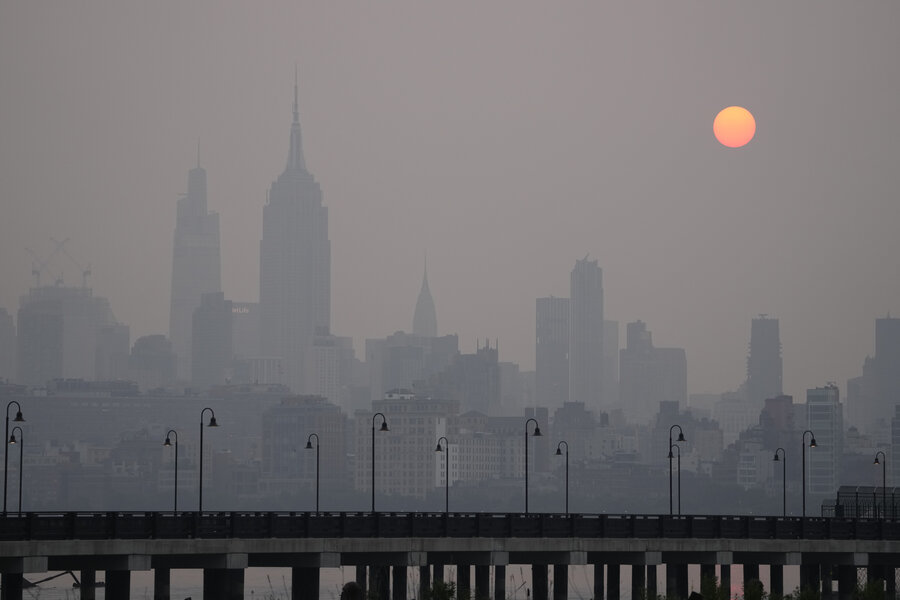Canadian wildfires are clouding US skies. Here's what to know.
Loading...
Intense Canadian wildfires are blanketing the northeastern United States in a dystopian haze, turning the air acrid, the sky yellowish gray, and prompting warnings for vulnerable populations to stay inside.
The effects of hundreds of wildfires burning across the western provinces of Quebec could be felt as far away as New York City and New England, blotting out skylines and prompting air quality alerts by U.S. authorities. Hazy conditions and smoke from the wildfires were reported across the Great Lakes region from Cleveland to Buffalo.
A smoky haze that hung over New York City much of the day Tuesday thickened in the late afternoon, obscuring views of New Jersey across the Hudson River and making the setting sun look like a reddish orb. In the Philadelphia area, dusk brought more of a lavender haze.
Sal and Lilly Murphy, of Brooklyn, likened the burning scent to a campfire. They said they could even smell the smoke indoors, in a Manhattan restaurant, then walked outside and saw a sky that looked like it was about to storm – but was rainless. Ms. Murphy wore a mask for protection.
“It’s a little scary,” Mr. Murphy said.
Smoke from the fires has wafted through northeast U.S. states for weeks now, but it’s only recently been noticeable in most places.
New York Gov. Kathy Hochul said Tuesday’s hazy skies “were hard to miss,” and New York City Mayor Eric Adams encouraged residents to limit outdoor activities “to the absolute necessities.”
Here’s a closer look at what’s happening and some suggested precautions for dealing with the haze:
What’s happening?
Smoke from Canada’s wildfires has been moving into the U.S. since last month. The most recent fires near Quebec have been burning for at least several days.
The U.S. Environmental Protection Agency said hazy skies, reduced visibility, and the odor of burning wood are likely, and that the smoke will linger for a few days in northern states.
“It’s not unusual for us to get fire smoke in our area. It’s very typical in terms of northwest Canada,” said Darren Austin, a meteorologist and senior air quality specialist with the Rhode Island Department of Environmental Management. But, usually, the smoke has been aloft and hasn’t affected people’s health, he said.
The Quebec-area fires are big and relatively close, about 500 to 600 miles away from Rhode Island. And they followed wildfires in Nova Scotia, which resulted in a short-lived air quality alert on May 30, Mr. Austin said.
Jay Engle, a National Weather Service meteorologist based in Upton, Long Island, said the wind trajectory that allowed smoke and hazy conditions to be seen in the New York City area could continue for the next few days. Of course, he said, the main driver of conditions is the fires themselves. If they diminish, the haze would, too.
What’s the biggest concern?
Air quality alerts are triggered by a number of factors, including the detection of fine-particle pollution – known as “PM 2.5” – which can irritate the lungs.
Trent Ford, the state climatologist in Illinois, said the atmospheric conditions in the upper Midwest creating dry, warm weather made it possible for small particulates to travel hundreds of miles from the Canadian wildfires and linger for days.
“It’s a good example of how complex the climate system is but also how connected it is,” Mr. Ford said.
What can you do for now?
It’s a good time to put off that yard work and outdoor exercise. If you go out, consider wearing an N95 mask to reduce your exposure to pollutants.
Stay inside, keeping your doors, windows, and fireplaces shut. It’s recommended that you run the air conditioning on a recirculation setting.
This story was reported by The Associated Press. AP reporters Katie Foody in Chicago and David B. Caruso and Deepti Hajela in New York contributed to this story.







